Samsung Galaxy S 5 Review
by Anand Lal Shimpi & Joshua Ho on April 8, 2014 12:00 AM EST- Posted in
- Smartphones
- Samsung
- Mobile
- Galaxy S 5
CPU Performance
The Galaxy S 5 marks the second Snapdragon 801 based device we've reviewed at AnandTech, the first being HTC's M8. I've gone through the Snapdragon 801 in depth already, but we're basically dealing with a reasonable upgrade to Snapdragon 800 on an improved 28nm HPm process. The bulk of the improvements impact GPU and ISP performance, but the SoC is just better overall. GS5 owners are lucky as all versions of the device that use Qualcomm silicon feature the MSM8974AC v3 SKU, which includes four 2.5GHz Krait 400 cores and a 578MHz Adreno 330 GPU.
| Snapdragon 800/801 Breakdown | ||||||||||
| SoC Version | Model | Max CPU Frequency | Max GPU Frequency | ISP | eMMC | DSDA | Memory IF | |||
| MSM8974VV | v2 | S800 | 2.2GHz | 450MHz | 320MHz | 4.5 | N | 800MHz | ||
| MSM8974AA | v2 | S800 | 2.3GHz | 450MHz | 320MHz | 4.5 | N | 800MHz | ||
| MSM8974AB | v2 | S800 | 2.3GHz | 550MHz | 320MHz | 4.5 | N | 933MHz | ||
| MSM8974AA | v3 | S801 | 2.3GHz | 450MHz | 320MHz | 5.0 | Y | 800MHz | ||
| MSM8974AB | v3 | S801 | 2.3GHz | 578MHz | 465MHz | 5.0 | Y | 933MHz | ||
| MSM8974AC | v3 | S801 | 2.5GHz | 578MHz | 465MHz | 5.0 | Y | 933MHz | ||
Although Samsung was the first major OEM to be caught cheating in Android benchmarks, it appears to have completely abandoned the practice with the Galaxy S 5's shipping software. Not only was I unable to find any evidence of the old cheats, I couldn't find any evidence of HTC's new subtle cheating either. The Galaxy S 5 appears to be clean as far as I can tell. Kudos to Samsung on doing the right thing, and I hope all other OEMs take this as a sign to stop the silliness.
For our performance tests I turned to our usual suite of browser and native applications. If there's one obvious takeaway from our CPU tests it's that despite having faster silicon than HTC's M8, the GS5 isn't always faster. I believe this has more to do with thermals than anything else. HTC's metal chassis is able to do a better job of dissipating heat than the GS5's plastic chassis. I don't believe there's a substantial impact on user experience, but it's interesting to note how choice in materials can have a performance impact like this.
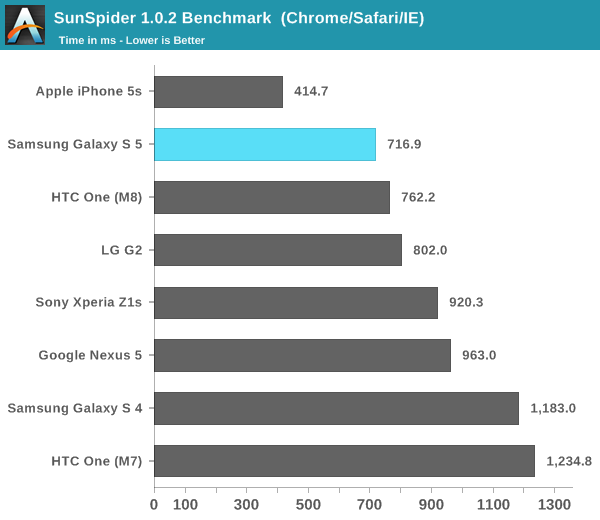
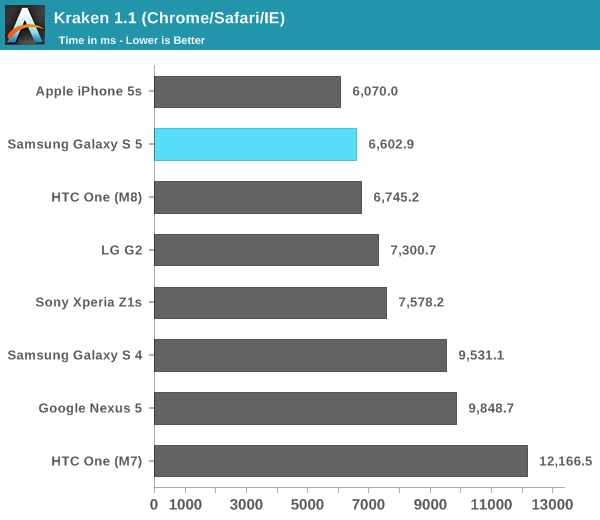
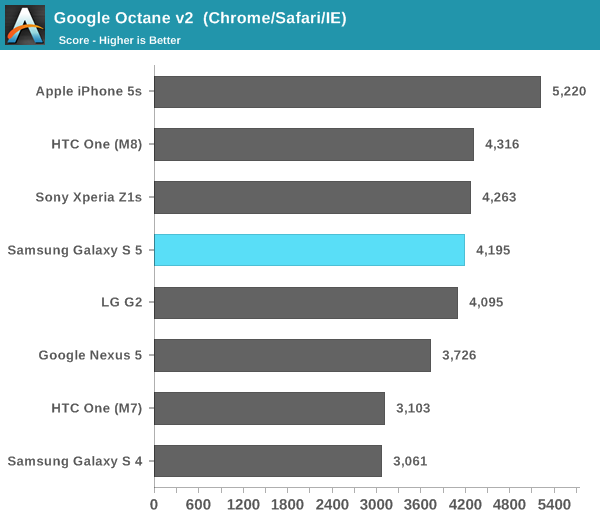
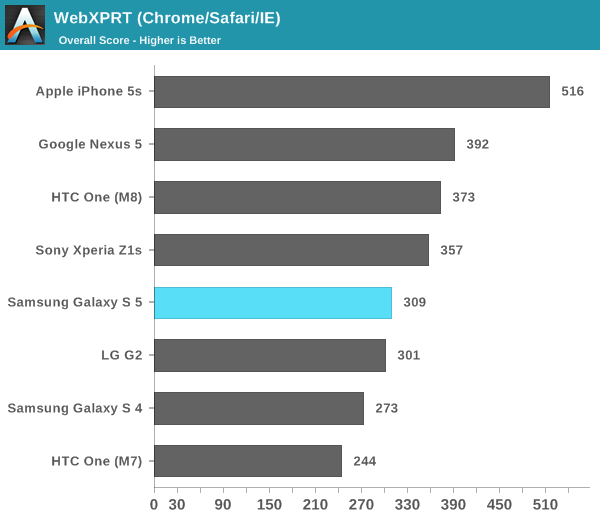
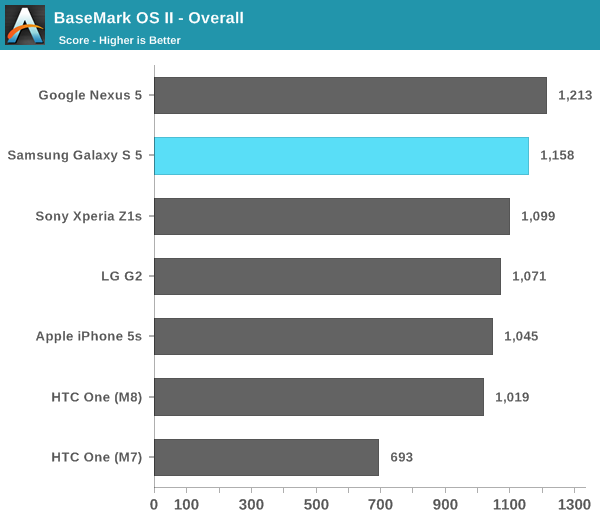
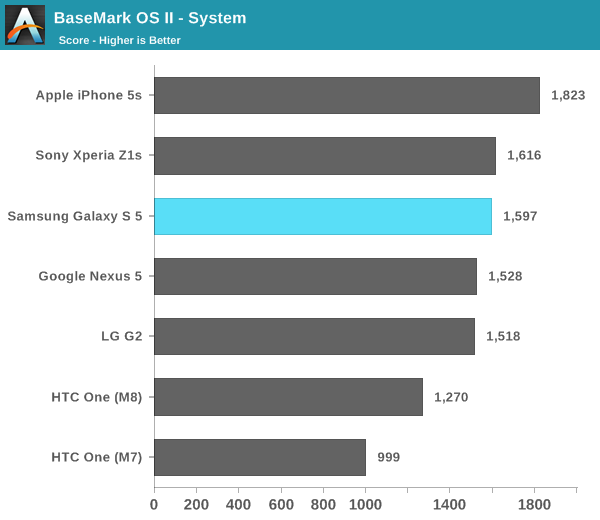
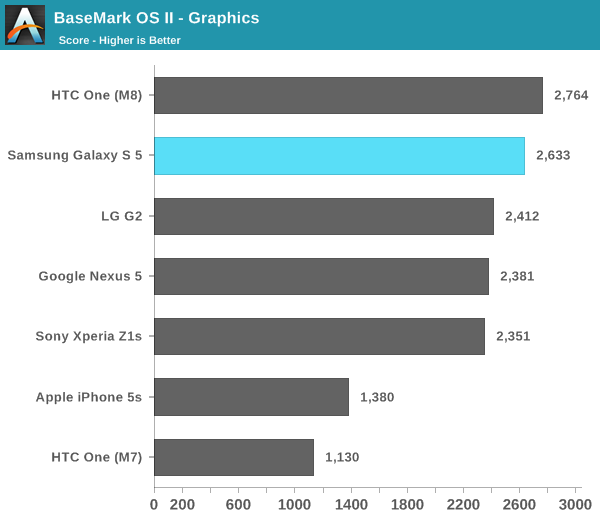

GPU Performance
GPU performance remains where we see the biggest benefit from Snapdragon 801 vs. 800, and since the GPU gains are almost entirely due to frequency scaling it's not too surprising that the M8 pulls ahead of the GS5 here in most cases.
There aren't any surprises here. The Adreno 330 in the Galaxy S 5 is more than capable of driving the device's 1080p display both in current and near term future 3D games.
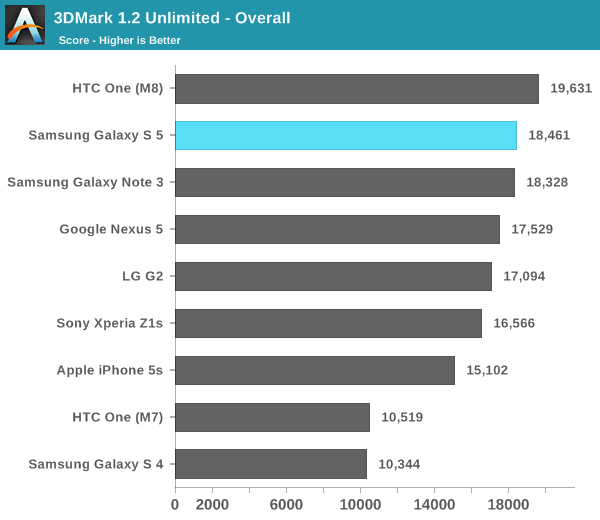
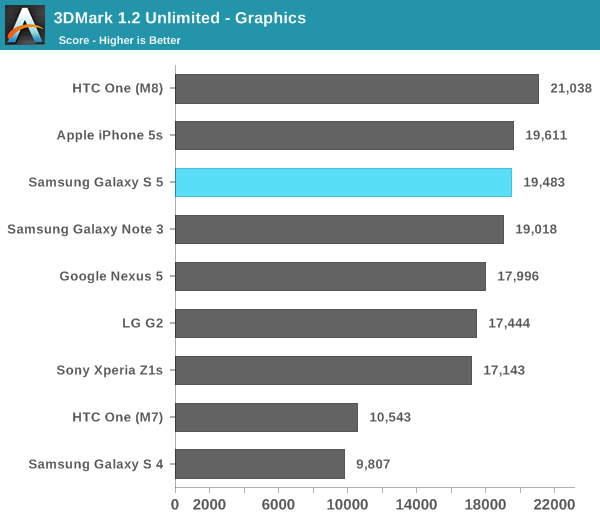
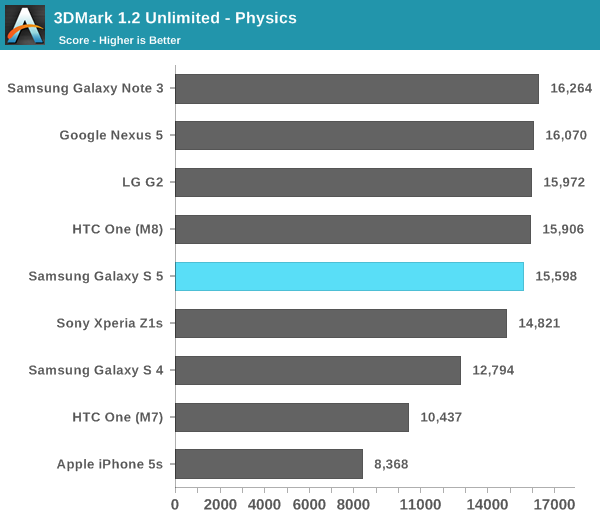
BaseMark X 1.1
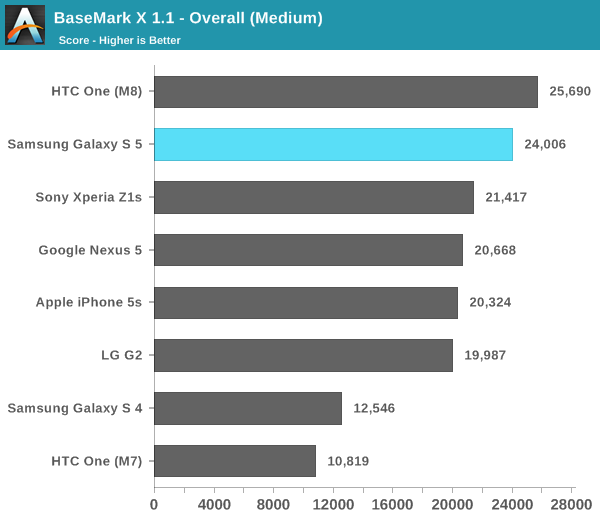

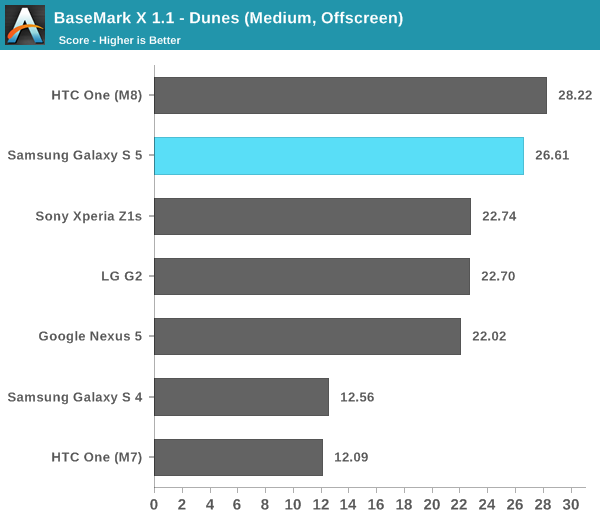
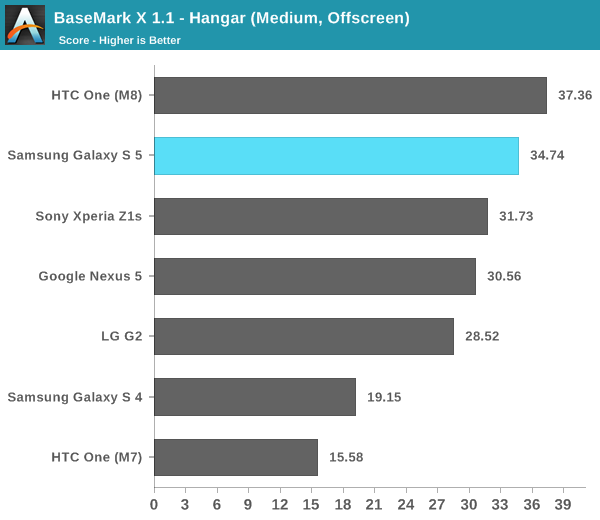

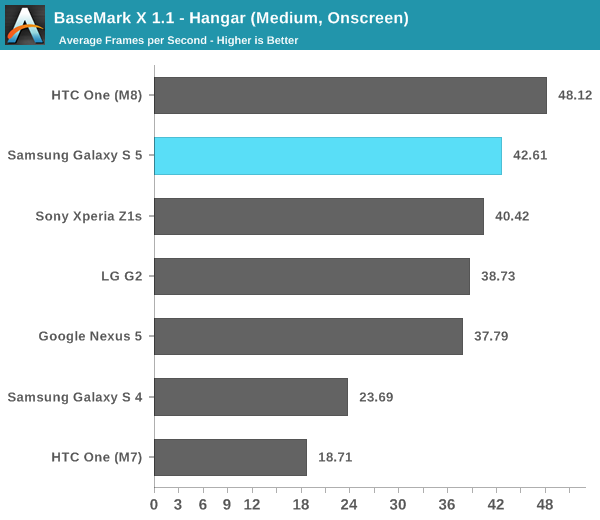
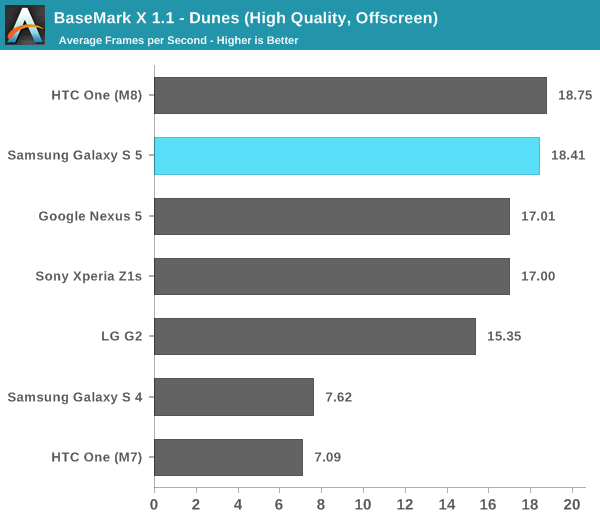
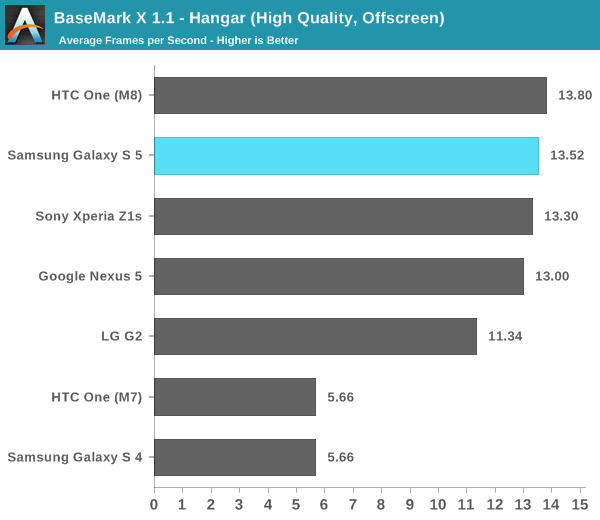
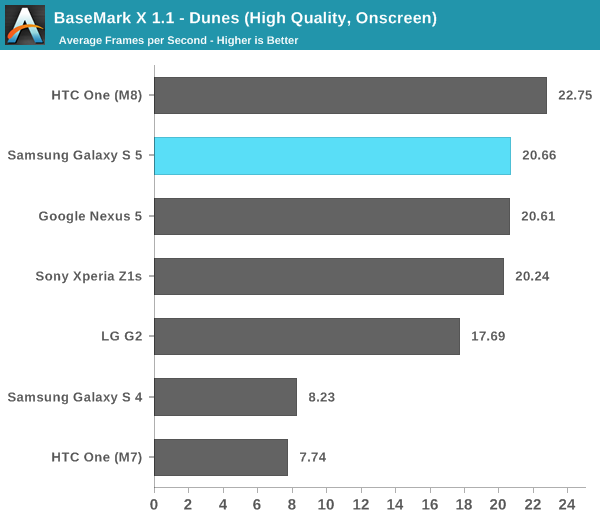
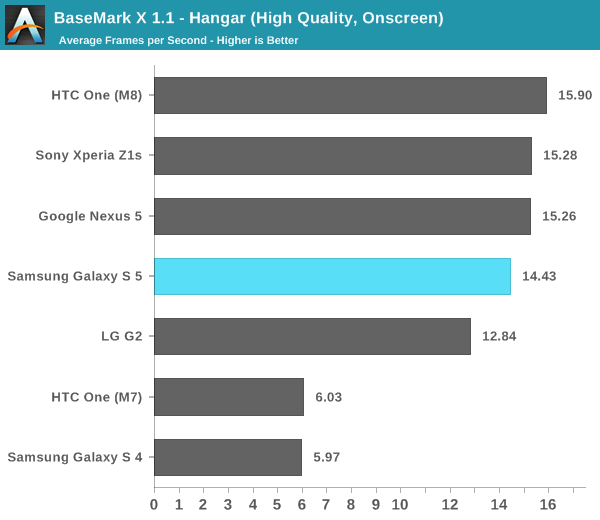
GFXBench 3.0
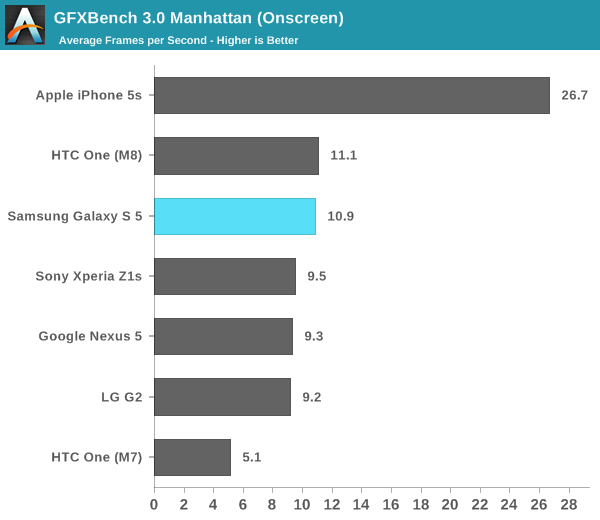
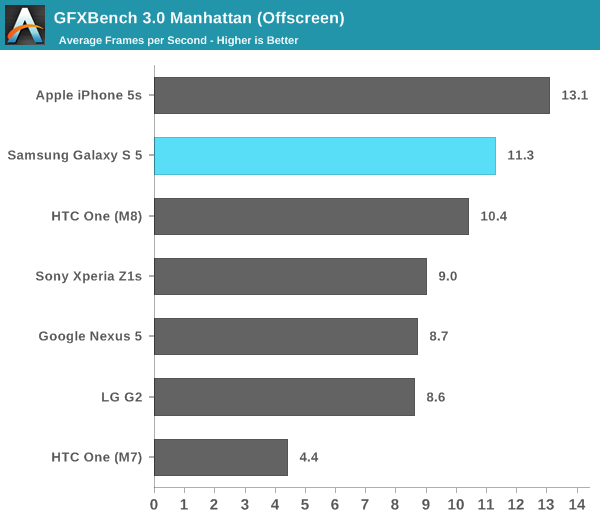
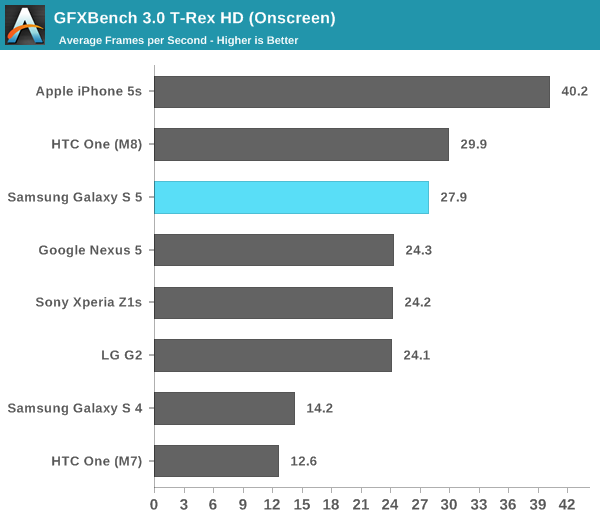
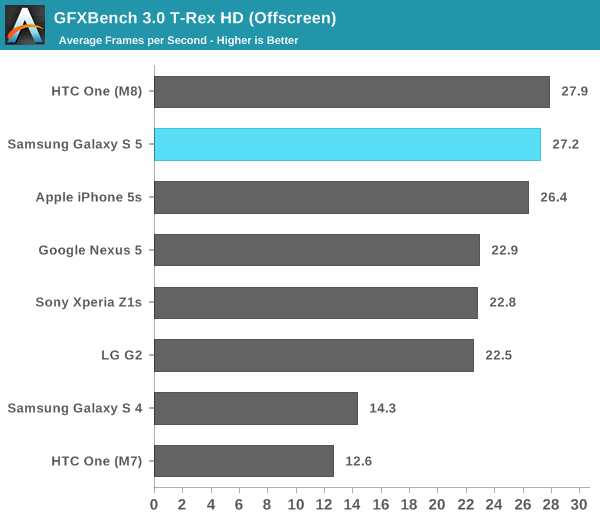

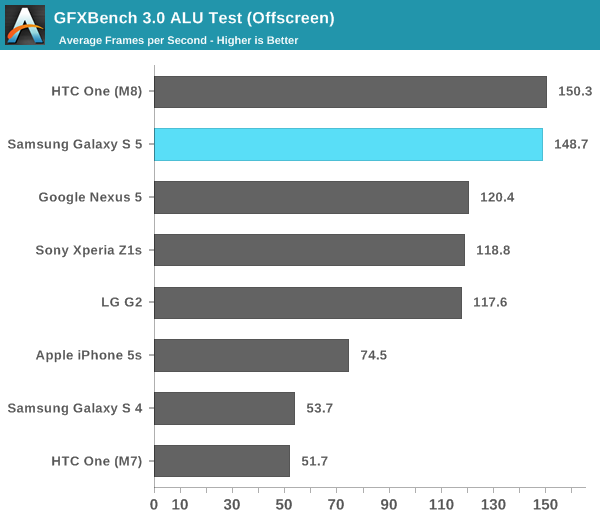


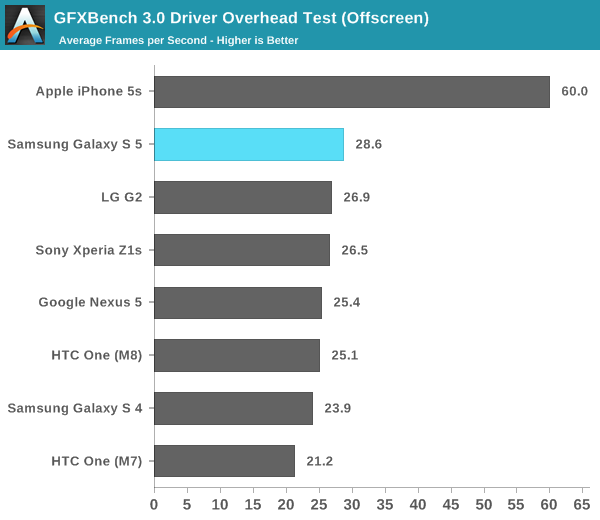
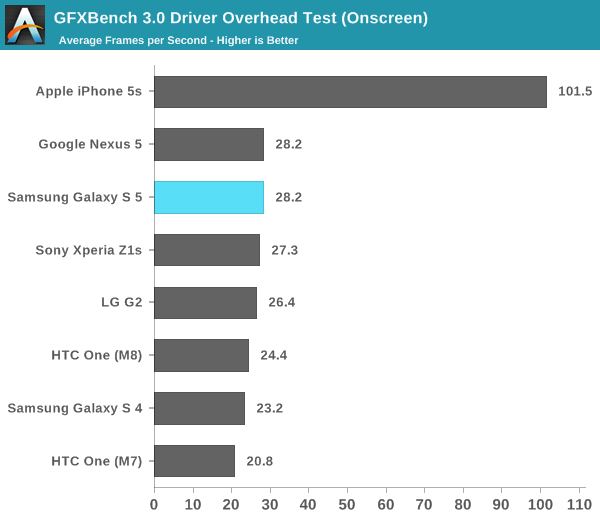
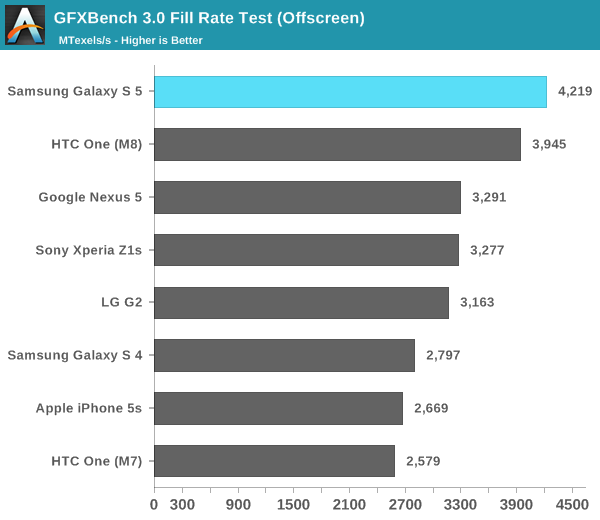
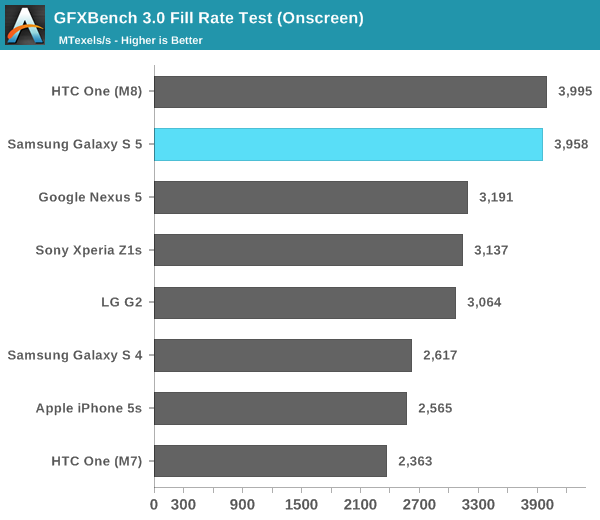
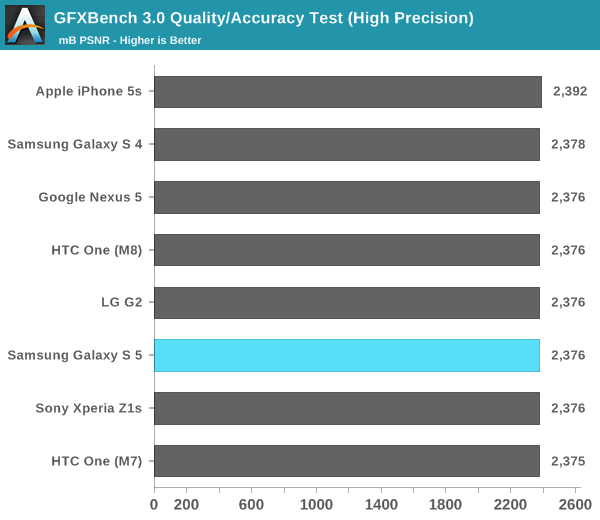
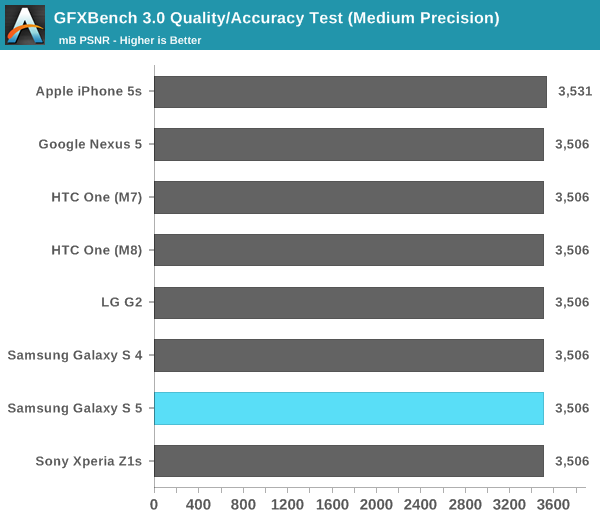
NAND Performance
The GS5 ships with 16GB or 32GB of NAND internally on an integrated eMMC device. Expansion is supported through a microSD card slot behind the removable back cover. Although the Snapdragon 801 inside supports eMMC 5.0, that alone doesn't guarantee a substantial increase in NAND performance. Keep in mind that most OEMs find multiple sources for their internal eMMC/NAND solutions, so what I'm testing here may only be representative of a portion of all GS5 devices.
Samsung sampled a 16GB GS5 review device. I put it through our usual random/sequential IO tests on a 100MB span of LBAs.
Random read performance is disappointing, it falls behind all modern devices we've tested. Random write performance is middle-of-the-road at best. It's unclear to me if this is a cost optimization or a lack of concern for NAND performance, but either way I'd rather see these metrics improve rather than regress.
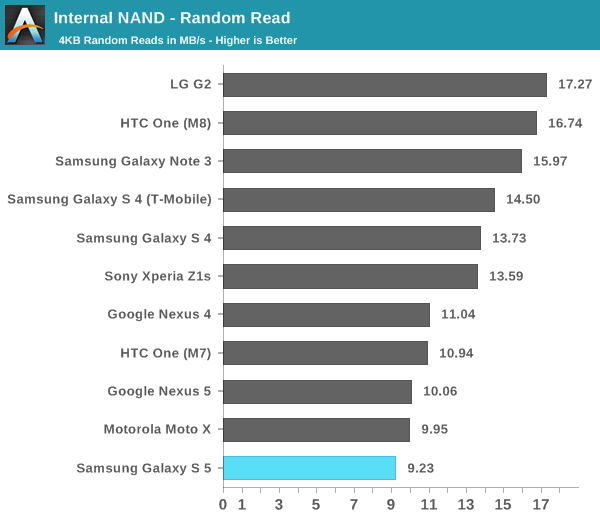
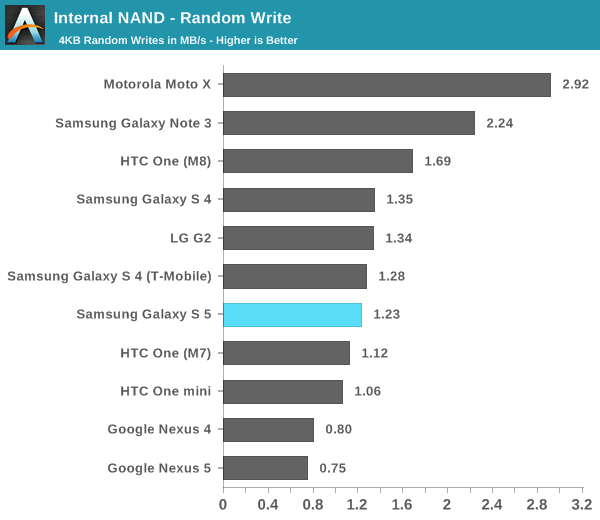
Sequential read/write performance both improve handsomely compared to the Galaxy S 4. I can see why Samsung would want to optimize for these two cases as they are quite common in regular usage, but random read/write performance can also significantly impact user experience.
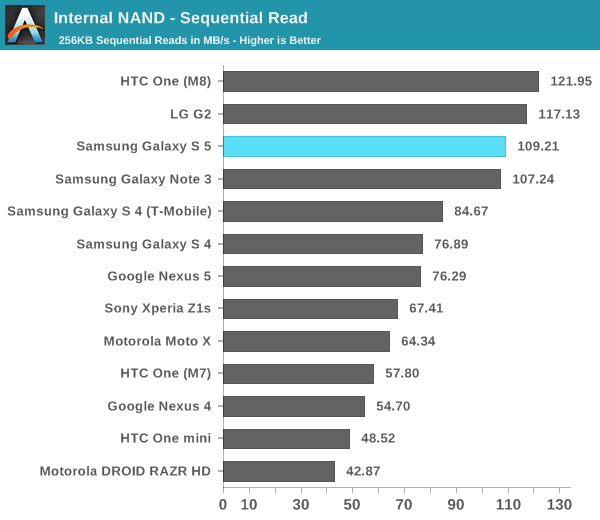
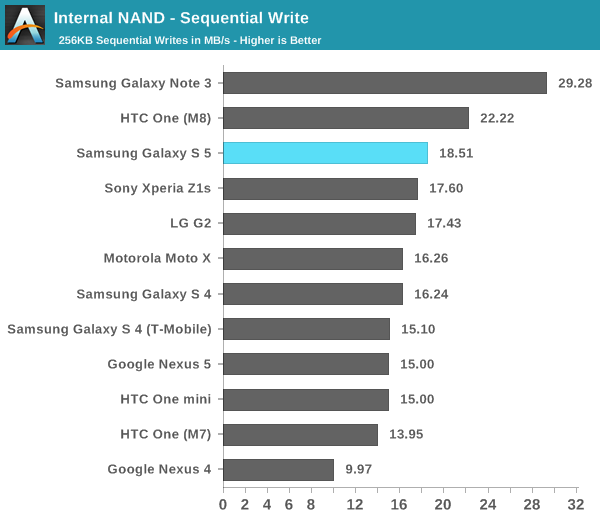










296 Comments
View All Comments
kmmatney - Tuesday, April 8, 2014 - link
I've gone through so many micro USB cables - the lightening connector is certainly something Apple got right.ΔrNTA - Wednesday, April 9, 2014 - link
And the EU want to make all phones have a Micro USB connector as standard. That could be trouble.Arbie - Tuesday, April 8, 2014 - link
I agree: No microSD = No Sale, so the Nexus 5 is not an option.Arbie - Tuesday, April 8, 2014 - link
Yeah, streaming is possible. It's just hugely more expensive and infinitely less reliable than having what you want on an SD card. So what is your point?Asylum1621 - Tuesday, April 8, 2014 - link
When you say "I can see why Samsung would want to optimize for these two cases as they are quite common in regular usage" what is this based on? Usage models show that >90% of commands sent to eMMC during regular usage are 4k random writes. Sequential read and write is rarely used in the system, and most sequential read/write events are not dependent on eMMC having great sequential performance, ie video playback, recording video using built-in camera, etc.kelemvor33 - Tuesday, April 8, 2014 - link
I'd love to see the GS3 in some of these charts to get a good comparison of how the GS line has improved over time. I have a GS3 and my 2 years is up this fall so the GS5 will be an option for me. The GS4 wasn't due to timing so having the 3, 4, and 5 in there would be more beneficial info to have.rrecine - Tuesday, April 8, 2014 - link
Metal does not mean a phone is built better than another phone. Metal is for isheep and magnets.akdj - Wednesday, April 9, 2014 - link
Must not have read...or comprehended the review? Metal is an incredible conductor of heat, a natural 'heatsink' for the 'guts'. See the scores in the M8 vs S5? Consistently higher benchmarks and faster, longer performance without throttling due to the ability of metals to dissipate that heat. Plastic is more insulator than anything. I own the Note 3, had the S3 and original Note as well. Metal, Apple's 'plastic' and all the Nokias I've seen have significantly better plastic build quality than my Sammys. To defend samsung and their use of extremely cheap 'housings' on the high end phones is silly. Kinda the joke of the entire industry. Such cool ideas, fast processing, great displays and digitized screens with styli... Yet they have FINALLY gotten around to improving TouchWiz...a bit more refined this time around, still kinda 'old' looking and heavy with crap you won't use...NOR have they increased or 'bettered' their manufacturing process when it comes to building the phone housing. I'm not saying it HAS to metal, though the iPhone is gorgeous, as are the latest HTCs and XPerias...but plastics can be molded, hardened, shined up and 'feel' solid if done right. Samsung's cheap rear plate is a joke. Nice to access a battery, but I've never owned a second one...my Note 3 will last two days. Nice to have the SD storage. And IMHO they actually did a pretty good job with the N3's 'textured' faux leather design on the black model. I'll hold judgement on this one til I see it...but @ 5.1" it's starting to creep into that Note/Phablet territory...one a bit more niche than the typical user. I love my Note3 but it's a two handed device for everything and anything I do with it. Even after owning one for two and a half years, I still hate using it as a phone. Too damn big. But anymore, talking on our phones is tertiary. MMS,SMS, Facebook and Twitter, emails and texts. So many more efficient ways to communicate. But when you've got to make a call, it's nice to have a comfortable phone. I love the iPhone for a lot of reasons, but a big one is the ease of one handed use. While the N3 has the 4" small screen option, the hardware is still in the same spot so it's kinda useless with the exception of phone dialing or single handed texting.doobydoo - Friday, April 11, 2014 - link
Good post.maecenas - Tuesday, April 8, 2014 - link
"Pretty much all the flagships offer some set of tradeoffs that prevent any one from being the perfect device (iPhone's screen size...)"Not really what I would choose to knock the iPhone - in my opinion the iPhone is about the right size and screen size is a knock against pretty much everyone else. That said, iPhone doesn't allow MicroSD expansion, doesn't feature different screen size options, has the closed Apple environment, charges outrageous prices for storage expansion - there are a lot of less subjective criticisms that can be made.